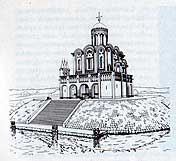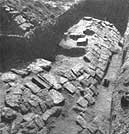| Виртуальный Владимир » Город Владимир » Old Russian Towns » Bogolyubovo » Church of the Intercession on the Nerl » reconstraction |
 ...
... reconstraction
reconstractionLooking at this exquisite church where everything down to the smallest detail is fused into a perfect unity, one would never doubt that its architects built it in the form in which we see it today.
 However the church itself originally formed part of a larger ensemble. On the south wall we can see the archway which led to the choir-gallery. For a long time it was unclear how the choir-gallery was reached, but excavations carried out in the middle of the last century and later from 1954-1955 proved that the church had originally been built with a network of adjoining structures surrounding it. As in the case of the Cathedral of St. Dmitri and the Bogolyubovo Cathedral, the walls of the church were carefully decorated in spite of the fact that part of them was to be obscured by these adjoining structures. Excavations revealed the foundations of a stone gallery which encircled the church on three sides. The southwest corner of the gallery contained a staircase in a specially thick wall, leading to the choir-gallery. Fragments and carvings found during excavations have made it possible to reconstruct the original appearance of the church and its galleries. This reconstruction can only give us a general idea of the basic design of the ensemble, of course.
However the church itself originally formed part of a larger ensemble. On the south wall we can see the archway which led to the choir-gallery. For a long time it was unclear how the choir-gallery was reached, but excavations carried out in the middle of the last century and later from 1954-1955 proved that the church had originally been built with a network of adjoining structures surrounding it. As in the case of the Cathedral of St. Dmitri and the Bogolyubovo Cathedral, the walls of the church were carefully decorated in spite of the fact that part of them was to be obscured by these adjoining structures. Excavations revealed the foundations of a stone gallery which encircled the church on three sides. The southwest corner of the gallery contained a staircase in a specially thick wall, leading to the choir-gallery. Fragments and carvings found during excavations have made it possible to reconstruct the original appearance of the church and its galleries. This reconstruction can only give us a general idea of the basic design of the ensemble, of course.
Unlike the Cathedral of St. Dmitri, the Church of the Intercession on the Nerl had open galleries. The pillars, decorated with fine carving and frontal semi-columns, were topped by arches. The arcade submerged the base of the church with its carved portals in airy semi-darkness so that it seemed to be suspended on light supports. The arcade was connected to the church by a balcony paved with majolica tiles. On the parapet of the balcony, which obscured the band of blind arcading on the church itself, the architects repeated the arcading motif. We do not know how or where the carved griffins and other monsters were arranged but the largest of them, the leaping snow leopards which were the emblem of the Vladimir princes, probably decorated the main south wall of the gallery facing the mouth of the river.

 Excavations have also revealed some interesting facts about the building of the church. Prince Andrei evidently gave strict instructions as to its exact site. But in those days spring floods used to cover these low-lying meadows with about ten feet of water. The builders accepted the challenge. They laid an ordinary foundation of small stones, five feet deep, on a layer of Jurassic clay. For added stability the foundations of the walls and pillars were linked by a network of secondary foundations. Finally, the base for the walls was built from smoothly hewn stone 11 feet high, and given a double coating of sandy-loam clay soil, inside and out, ramming it down firmly. This produced an artificial hillock protecting the foundations of the church which were sunk into it at a depth of over 16 feet. The church and its galleries were erected on this base, well above the high-water mark. The builders went even further and paved the hillock with stone slabs and gutters for drainage like those in the Bogolyubovo palace. Thus the hillock was given a protective stone casing. Standing on its stone island amid the swirling floods, the church must have seemed like a miraculous apparition. Thanks to the skill and ingenuity of its builders the Church of the Intercession has survived eight centuries with the flood waters of the Nerl and Klyazma lapping at its base each spring.
Excavations have also revealed some interesting facts about the building of the church. Prince Andrei evidently gave strict instructions as to its exact site. But in those days spring floods used to cover these low-lying meadows with about ten feet of water. The builders accepted the challenge. They laid an ordinary foundation of small stones, five feet deep, on a layer of Jurassic clay. For added stability the foundations of the walls and pillars were linked by a network of secondary foundations. Finally, the base for the walls was built from smoothly hewn stone 11 feet high, and given a double coating of sandy-loam clay soil, inside and out, ramming it down firmly. This produced an artificial hillock protecting the foundations of the church which were sunk into it at a depth of over 16 feet. The church and its galleries were erected on this base, well above the high-water mark. The builders went even further and paved the hillock with stone slabs and gutters for drainage like those in the Bogolyubovo palace. Thus the hillock was given a protective stone casing. Standing on its stone island amid the swirling floods, the church must have seemed like a miraculous apparition. Thanks to the skill and ingenuity of its builders the Church of the Intercession has survived eight centuries with the flood waters of the Nerl and Klyazma lapping at its base each spring.
There were good reasons behind the choice of the site, in spite of the problems which it presented to the builders. The River Nerl crossed the principality linking its main towns with the Klyazma and the major waterways of the Oka and Volga. Vessels from Suzdal and Rostov and ships bringing envoys and guests from Asia and neighbouring lands all sailed past the magnificent church. It was one in a series of buildings designed to impress the traveller with the might of the Vladimir princes. Behind it could be seen the white walls of the royal residence at Bogolyubovo, and a few miles further on were the splendid, sumptuous buildings of the capital itself, Vladimir. The breadth of vision displayed by the Vladimir builders was akin to that of the Novgorod architect, Pyotr, who built the mighty cathedrals of the Antoniev and Yuriev monasteries on the banks of the River Volkhov at the approaches to Novgorod. It is possible that the illustrious guests and envoys used to break their journey at the Church of the Intercession and climb up the steps of the stone slope to attend a service in the choir-gallery before continuing on their way to Bogo-lyubovo or Vladimir.
Legend has it that this church was erected to commemorate Prince Andrei's victorious campaign against the Volga Bulgars in 1164, and that it was built of stone brought here by the defeated enemy as a form of tribute. It is possible that this victory is represented by the carved griffins with lambs in their claws. The church was also built in memory of Andrei's son, Izyaslav, who was killed during the campaign. Finally, it was dedicated to a new festival, the Intercession of the Virgin, which had been instituted by Andrei and the Vladimir church authorities without the consent of the Metropolitan of Kiev and the Patriarch. This festival emphasised the special protection granted to the Vladimir dynasty and its lands by the Virgin Mary.
All these factors contributed to its majestic splendour and might. The impressive, graceful tiered design is typical of many Russian churches, beginning with the Cathedral of St. Sophia in Kiev built on the spot where Yaro-slav inflicted a crippling defeat on the Pecheneg nomads. The tiered design of the Church of the Intercession was particularly effective. It began with the stone hill at the foot of the building, continuing with the arched tier of the gallery, up to the main body of the church itself and, finally, the light cylinder of the dome drum where the strong, soaring lines merged gently into the helmet-shaped dome crowned with an open-work, gilded cross. This church is, undoubtedly, a masterpiece of Vladimir twelfth-century architecture.
Оставить комментарий:



 Виртуальный Владимир
Виртуальный Владимир Область
Область Панорамы города
Панорамы города Организации
Организации Улицы и дома
Улицы и дома Добавить организацию
Добавить организацию О городе
О городе










